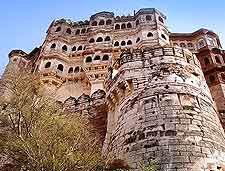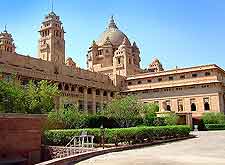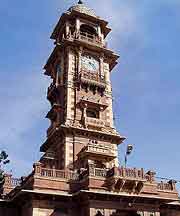Jodhpur History Facts and Timeline
(Jodhpur, Rajasthan, India)

The Rajasthani city of Jodhpur's history began in the 8th century as part of the Gurjara-Pratihara Empire, although the city itself was officially founded by a Rajput leader of the Rathore Dynasty, Rao Jodha, some 600 years later in 1459.
Set on a busy camel trail route linking Gujarat with Delhi, the city was sustained by trade in opium, dates, coffee, silk and copper, and it soon became the capital of the Marwar region, which was conquered by the dynasty through a series of marital alliances.
The Mughal Years
During the reign of Mughal Emperor Shah Akbar, Jodhpur and the Marwar state came under the great empire's domination as a fief. A degree of autonomy was negotiated by the Rathore Dynasty, who supplied notable warriors to the Mughal armies in return. In the last half of the 16th century, the then ruler Rajah Maldeo extended the influence of the city by acquiring Ajmer, Nagore and Jalore during a time of much conflict between states.

Mughal Decline and Civil War
The Mughal influence on the history of Jodhpur was strongest in the fields of the arts, religion and culture, with new architectural styles and a wider world view encouraging local traders to branch out into the hinterlands of India, where they met with great success.
During the decline of the Mughal Empire in the early 18th century, the ruler of Jodhpur was at odds with his court. This resulted in intrigue and caused disturbances across the state, with half a century of civil war decimating the region's economy.
The British Raj in Jodhpur
Exhausted by the years of conflict, the state and its capital formed an alliance with the British Empire in 1818, gaining peace, stability and a chance to regain its fortunes as a result. Its merchant class, the Marwaris, eventually dominated trade in India up until independence in 1947, happily reversing the city's former poor economic status.

Post Independence
After independence was declared, the Marwar state became part of the Indian Union and the city was Rajasthan's second-most important conurbation, with the region and its neighbouring Gorwar region ruled by the Maharajas of Jodhpur. The incorporation of Gorwar resulted in great wealth being donated to Jodhpur by members of the Jain faith, strengthening the city's fiscal position.
Over its history, Jodhpur spread out to incorporate the state's former capital, Mandore, the ruins of which can be seen today near the Mandore Gardens.
The great fort, the first of Rao Jodha's constructions in 1458, still looms over the city from its hill and remains in remarkable condition. It includes the extravagantly decorated palace of the ruling dynasty, as well as the harem. The present Maharaja of Jodhpur lives in the city's newest palace, the Umaid Bhawan, half of which is now a five-star hotel.
 The Rajasthani city of Jodhpur's history began in the 8th century as part of the Gurjara-Pratihara Empire, although the city itself was officially founded by a Rajput leader of the Rathore Dynasty, Rao Jodha, some 600 years later in 1459.
The Rajasthani city of Jodhpur's history began in the 8th century as part of the Gurjara-Pratihara Empire, although the city itself was officially founded by a Rajput leader of the Rathore Dynasty, Rao Jodha, some 600 years later in 1459.
